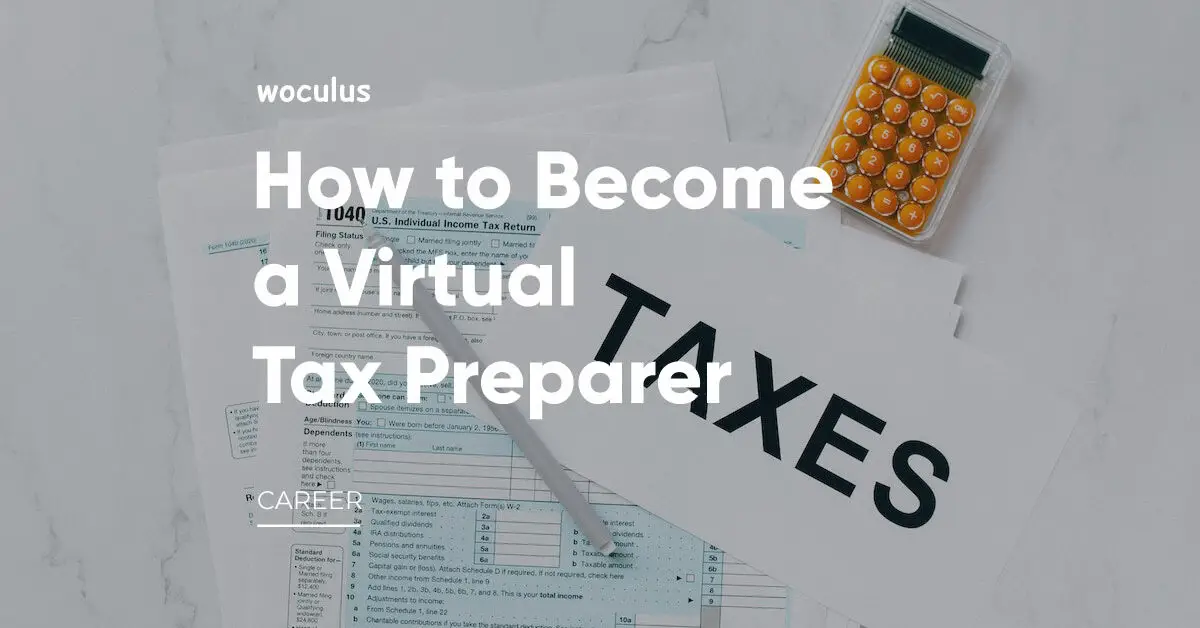If you are detail-oriented, organized, and comfortable working with numbers, then becoming a virtual tax preparer might be an excellent career.
Tax season can be a daunting time for many individuals and businesses. The paperwork, rules, and regulations can seem overwhelming, leaving many people feeling lost and confused. However, with the rise of virtual tax preparation services, it has never been easier to navigate the tax landscape.
This blog post will discuss how to become a virtual tax preparer and take advantage of this growing industry. Whether you are looking for a career change or a side hustle, virtual tax preparation can be a lucrative and fulfilling opportunity. So, let’s dive in and learn how you can become a virtual tax preparer and help people navigate the often-complex world of taxes.
Working from Home as a Tax Preparer
As a tax preparer, working from home can offer several advantages, such as greater flexibility in scheduling and reduced commute time. However, there are essential things to consider before switching to remote work.
- Equipment and Technology: Make sure you have a reliable computer and internet connection, as well as any necessary software and hardware for tax preparation. You may also want to invest in a printer, scanner, and other office equipment.
- Security: Ensure that your computer and network are secure from hackers and other threats. Use strong passwords, update your antivirus and firewall software, and use encryption when transmitting sensitive data.
- Compliance: Ensure you comply with any regulations related to working from home as a tax preparer. This could include obtaining any necessary licenses or permits and ensuring that you are following all relevant tax laws and regulations.
- Communication: Stay in touch with your clients and colleagues through email, phone, or video conferencing. Ensure you have a system for securely exchanging documents and other sensitive information.
- Work-life balance: When working from home, it can be easy to blur the lines between work and personal time. Set boundaries and establish a routine to help maintain a healthy work-life balance.
How to Become an Insurance Agent from Home
Skills for A Virtual Tax Preparer
As a virtual tax preparer, you need specific skills to help you deliver excellent service. So we have listed some skills below to give you an idea of what to expect as you start your career virtually as a tax preparer.
- Tax knowledge: A virtual tax preparer should have a solid understanding of tax laws and regulations, as well as the ability to keep up with updates and changes.
- Attention to detail: Preparing tax returns requires a great deal of accuracy and attention to detail. A virtual tax preparer should be able to review and double-check work to ensure there are no errors.
- Organization: A virtual tax preparer should be able to stay organized and manage their workload effectively. This includes keeping track of deadlines, documents, and client information.
- Technology skills: As a virtual tax preparer, you’ll need to be familiar with the software and tools used in tax preparation. This includes tax software, document management systems, and communication platforms.
- Communication skills: A virtual tax preparer must communicate effectively with clients via email, phone, or video conferencing. They should also be able to explain complex tax concepts clearly and concisely.
- Time management: A virtual tax preparer must be able to manage their time effectively to meet deadlines and ensure that clients receive their returns on time.
- Customer service: A virtual tax preparer should be able to provide excellent customer service, answering questions and addressing concerns in a timely and professional manner.
- Ethics and confidentiality: A virtual tax preparer should adhere to ethical standards and maintain client confidentiality at all times.
How to Write an Insurance Cancelation Letter + Samples
Becoming a Tax Preparer from Home
Many people go into remote work for many reasons, from flexible working hours to high-income potential, and tax preparer is no different. One advantage of being a remote tax preparer is the low barrier to entry. So how do you get into the business of working as a tax preparer from home?
1. Get Trained and Certified
To become a tax preparer, you need to know tax laws and regulations. There are several options for training and certification as a tax preparer. One popular option is to take an online course. Many companies offer online tax preparation courses covering tax law, tax forms, deductions, and credits. These courses can be completed at your own pace and typically cost a few hundred dollars.
Another option is to attend in-person classes offered by community colleges, vocational schools, or professional organizations. These classes typically follow a structured curriculum and may provide hands-on training.
Once you have completed your training, you can become certified by passing an exam. The most common certification is the IRS Annual Filing Season Program (AFSP). To become an AFSP participant, you must complete a certain number of continuing education hours, pass a tax preparer exam, and agree to abide by IRS ethical standards. Other certifications that tax preparers may pursue include the Enrolled Agent (EA) credential, which requires passing a comprehensive exam administered by the IRS, and the Certified Public Accountant (CPA) designation, which requires completing a degree program and passing the CPA exam.
2. Get Registered
If you want to work as a virtual tax preparer, you need to obtain a Preparer Tax Identification Number (PTIN) from the IRS. The PTIN is a unique identification number used to identify tax preparers and is required on all federal tax returns that you prepare. To obtain a PTIN, you will need to register with the IRS. You can register online at the IRS website or by completing Form W-12, IRS Paid Preparer Tax Identification Number (PTIN) Application.
Once you have obtained a PTIN, you will need to renew it annually. You will also need to notify the IRS if any of your information changes, such as your name, address, or business name.
3. Choose a Tax Preparation Software
Choosing the right tax preparation software is an important decision for any tax preparer. The software you choose will impact how efficiently you can complete tax returns, how easy it is to e-file returns, and the overall quality of your work. Many different tax preparation software options are available, ranging from simple online filing tools to more comprehensive software that includes advanced features and support. Some tax preparation software options include TurboTax, H&R Block, TaxAct, and Drake Tax.
Here are some factors to consider when choosing tax preparation software include:
- Price: Tax preparation software can range in price from free to several hundred dollars. Some software charges a flat fee per return, while others charge a monthly subscription fee.
- Ease of use: Look for software that is easy to navigate and has an intuitive interface. Some software may have more complicated features that require training to use.
- Features: Consider what features you need in tax preparation software. Do you need to handle complex returns? Do you need e-filing options? Do you need support for multiple clients?
- Support: Look for software that offers customer support, such as phone or email support. Some software may also provide training or user forums.
- Security: Make sure the software you choose has robust security measures to protect client data.
4. Build Your Client Base
You can start building your client base by advertising your services on social media, classified ads, or networking with other professionals. You can also join online marketplaces that connect tax preparers with clients. To build your client base, you need to reach out to family, friends, and acquaintances to inform them about your tax preparation services. Ask them to refer you to anyone they know who may need help with their taxes. Word-of-mouth referrals can be a powerful tool for building your client base.
You can also consider placing ads in local newspapers or community bulletin boards to attract potential clients. Distribute flyers or business cards in your local area. Encourage your current clients to refer their friends and family by offering a referral bonus. This could be a discount on their next tax return or a cash reward. Furthermore, you can partner with other local businesses, such as financial advisors or real estate agents, to generate leads. You can offer tax preparation services to your clients in exchange for referrals.
If you have experience or expertise in a particular area, such as self-employment taxes or small business taxes, consider marketing your services to that niche. By positioning yourself as an expert in a specific area, you can attract clients who need help with that type of tax return.
5. Stay Updated
As a virtual tax preparer, it is essential to stay updated on the latest tax laws and regulations to provide accurate and effective services to your clients. With the constant changes in tax laws, staying updated is not only important but necessary for your success as a tax preparer from home.
One effective way to stay updated is to use tax preparation software. Many software programs are updated regularly to reflect changes in tax laws and regulations. By using tax preparation software, you can ensure that your tax returns are accurate and up-to-date.
Another effective strategy is to join professional organizations, such as the National Association of Tax Professionals or the American Institute of CPAs. These organizations provide access to valuable resources, such as training, webinars, and industry news. They also offer opportunities to network with other tax professionals, which can be a great way to stay informed about industry developments.
Participating in continuing education courses is also essential for staying updated. Many states require tax preparers to complete a certain number of hours of continuing education each year.
6. Follow Ethical Standards
As a tax preparer from home, it is essential to follow ethical standards in all aspects of your work. Ethical standards are the moral principles that guide your behaviour and actions in the workplace.
Following ethical standards is essential to building trust with your clients. As a tax preparer, your clients entrust you with sensitive financial information. They expect you to keep their information confidential and to provide accurate and reliable tax services. By following ethical standards, you can demonstrate your commitment to maintaining their trust and confidence. One of the most effective strategies for following ethical standards is understanding the ethical rules and regulations governing tax preparation. The Internal Revenue Service (IRS) has established ethical standards for tax preparers, and it is essential to be familiar with these rules and regulations. These standards include maintaining confidentiality, avoiding conflicts of interest, and providing accurate and reliable services.
Maintaining clear and open communication with your clients is another effective strategy. This includes explaining your services, fees, and potential conflicts of interest. By being transparent with your clients, you can build trust and establish a strong working relationship. Finally, staying informed about ethical issues in the tax industry is essential for following ethical standards. This includes staying up-to-date on industry news, trends, and developments. By staying informed, you can identify potential ethical issues and take proactive steps to address them.
Remote Accountant Career Path: Everything You Need to Know
Software for A Virtual Tax Preparer
Several software options are available for a virtual tax preparer, each with its own features and pricing. Here are some popular options:
- TurboTax: TurboTax is a well-known tax preparation software that offers both online and desktop versions. It offers a user-friendly interface, a comprehensive questionnaire for tax-related information, and step-by-step guidance throughout the preparation process. TurboTax also provides several tools to help maximize deductions and credits, such as ItsDeductible for tracking charitable donations.
- TaxAct: TaxAct is another popular tax preparation software that offers a range of pricing options, including a free version. It provides a straightforward interface, along with various tools to help prepare and file taxes, such as a donation tracker and a deduction finder.
- H&R Block: H&R Block offers online and desktop software versions for tax preparation. Its software offers step-by-step guidance, an easy-to-use interface, and access to tax professionals for assistance. H&R Block also offers a range of tools, such as a tax calculator, to help users estimate their tax liability.
- TaxSlayer: TaxSlayer offers a range of pricing options for tax preparation, including a free version. Its software offers a user-friendly interface, step-by-step guidance, and access to tax professionals for assistance. TaxSlayer also provides several tools to help users prepare and file their taxes, such as a refund calculator and a deduction finder.
Note that when choosing a tax preparation software to work with, you should consider your specific needs, such as the complexity of your tax situation and the level of support you require. It’s also important to compare pricing and features across different software options to find the best fit for you.
Conclusion
In conclusion, becoming a virtual tax preparer can be a great career path for those who are detail-oriented, organized, and comfortable working with numbers. By following the steps outlined above, including obtaining the necessary education and certifications, you can set yourself apart from the competition and acquire success in this growing field. With dedication and hard work, anyone can become a successful virtual tax preparer and enjoy a rewarding career in this field.







